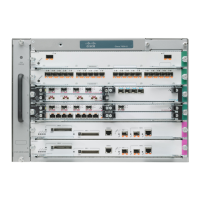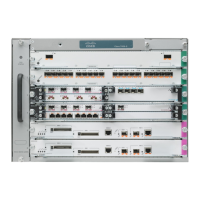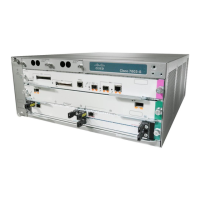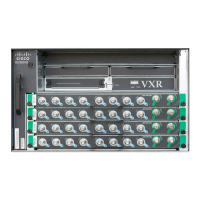9-12
Cisco 7600 Series Router Cisco IOS Software Configuration Guide—12.1E
78-14064-04
Chapter 9 Configuring VLANs
Configuring VLANs
This example shows how to verify the configuration:
Router# show vlan name VLAN0003
VLAN Name Status Ports
---- -------------------------------- --------- ---------------------
3 VLAN0003 active
VLAN Type SAID MTU Parent RingNo BridgeNo Stp Trans1 Trans2
---- ----- ---------- ----- ------ ------ -------- ---- ------ ------
3 enet 100003 1500 - - - - 0 0
Router#
Assigning a Layer 2 LAN Interface to a VLAN
A VLAN created in a management domain remains unused until you assign one or more LAN ports to
the VLAN.
Note Make sure you assign LAN ports to a VLAN of the appropriate type. Assign Ethernet ports to
Ethernet-type VLANs.
To assign one or more LAN ports to a VLAN, complete the procedures in the “Configuring LAN
Interfaces for Layer 2 Switching” section on page 7-7.
Configuring the Internal VLAN Allocation Policy
Internal VLAN allocation policy is supported in Release 12.1(13)E and later releases. For more
information about VLAN allocation, see the “VLAN Ranges” section on page 9-2.
Note The internal VLAN allocation policy is applied only following a reload.
To configure the internal VLAN allocation policy, perform this task:
When you configure the internal VLAN allocation policy, note the following syntax information:
• Enter the ascending keyword to allocate internal VLANs from 1006 and up.
• Enter the descending keyword to allocate internal VLAN from 4094 and down.
Command Purpose
Step 1
Router(config)# vlan internal allocation policy
{ascending | descending}
Configures the internal VLAN allocation policy.
Router(config)# no vlan internal allocation
policy
Returns to the default (ascending).
Step 2
Router(config)# end
Exits configuration mode.
Step 3
Router# reload
Applies the new internal VLAN allocation policy.
Caution You do not need to enter the reload command
immediately. Enter the reload command
during a planned maintenance window.

